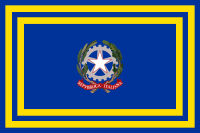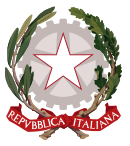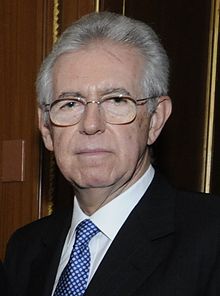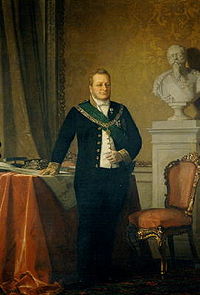- Prime Minister of Italy
-
President of the Council of Ministers of Italy
Presidente del Consiglio dei Ministri della Repubblica Italiana
Flag of the President of the Council of MinistersResidence Palazzo Chigi Appointer President of the Republic Inaugural holder Camillo Benso di Cavour Formation 17 March 1861 Website www.governo.it Italy 
This article is part of the series:
Politics and government of
ItalyConstitutionJudiciary- Constitutional Court
- Court of Cassation
- Court of Assizes
- Italian Council of State
- Italian Criminal Procedure
- Judiciary of Italy
Divisions- Regions
- Politics of Aosta Valley
- Politics of Piedmont
- Politics of Lombardy
- Politics of Veneto
- Politics of Trentino-Alto Adige/Südtirol
- Politics of Friuli-Venezia Giulia
- Politics of Emilia-Romagna
- Politics of Liguria
- Politics of Tuscany
- Politics of Umbria
- Politics of Marche
- Politics of Molise
- Politics of Lazio
- Politics of Abruzzo
- Politics of Campania
- Politics of Apulia
- Politics of Calabria
- Politics of Sicily
- Politics of Sardinia
- Provinces
- Municipalities
ElectionsForeign policy
The President of the Council of Ministers (Italian: Presidente del Consiglio dei Ministri), usually referred to in English as the prime minister of Italy, is the head of government of the Italian Republic. The formal Italian order of precedence lists the office as being ceremonially the fourth most important Italian state office, although in practice the prime minister is the most powerful, and thus de facto, leader of the Italian government.
While the office is similar to those in most other parliamentary systems, the Italian prime minister has less authority than some of his counterparts. The prime minister is not authorized to request the dissolution of the Parliament of Italy or to dismiss ministers, and must receive a vote of approval from the Council of Ministers—which holds effective executive power—to execute most political activities.
The office was established by Articles 92 through to 96 of the current Constitution of Italy. The prime minister is appointed by the President of the Republic after each general election. The formal title of the office holder is Presidente del Consiglio dei Ministri; the Italian word for "prime minister" is primo ministro.
Contents
History
The office was first established in 1848 in Italy's predecessor state, the Kingdom of Sardinia—although it was not mentioned in the constitution, the Albertine Statute. The candidate for office was appointed by the king, and presided over a very unstable political system. In its first 60 years of existence (1861-1921), Italy changed its prime minister 37 times. Regarding this situation, the first goal of Benito Mussolini, appointed in 1922, was to abolish the Parliament's ability to put him to a vote of no confidence, thus basing his power on the will of the king and the National Fascist Party alone. With the proclamation of the Italian Republic in 1946, the office received constitutional recognition, but it returned to its traditional instability: 25 men assumed the office in 65 years.
Functions
In addition to powers inherent in being a member of the cabinet, the prime minister holds specific powers, most notably being able to nominate a list of cabinet ministers to be appointed by the President of the Republic and the countersigning of all legislative instruments having the force of law that are signed by the President of the Republic.
Article 95 of the Italian constitution provides that "the prime minister directs and coordinates the activity of the ministers". This power has been used to a quite variable extent in the history of the Italian state, as it is strongly influenced by the political strength of individual ministers and thus by the parties they represent.
Often the prime minister's activity consists more in mediating between the various parties in the majority coalition, rather than directing the activity of the Council of Ministers. In addition the prime minister's supervisory power is further limited by the fact that, at least formally, he or she does not have the authority to fire those ministers with whom he or she might be in disagreement. The practice of rimpasto ("reshuffle"), or the rarer "individual vote of no confidence" on the part of Parliament, may be considered substitute measures for this formally absent power.
More recently, the rise of a new mode of politics, which according to some is ever more linked to the mediating skills of politicians, and the enactment of majoritarian electoral laws have, in practice, given the prime minister a greater power to make decisions and to direct the internal dynamics of the government.
See also
- List of Prime Ministers of Italy
- List of Presidents of the Italian Republic
- Italian Minister of the Interior
- Italian Minister of Foreign Affairs
- Italian Minister of Defense
- Italian Minister of Justice
- Italian Minister of Public Instruction
- Italian Minister of Health
- Italian Minister of Economy and Finance
- Italian Minister of Public Works
- Italian Minister of Transports
- Italian Minister of Economic Development
- Politics of Italy
- Lists of incumbents
References
- This article was translated from the equivalent article in Italian Wikipedia, retrieved 16 April 2006.
External links
- Website of the Prime Minister of Italy
- List of Italian Prime Ministers, with information on length of term and party membership
Prime Ministers of Italy Kingdom of Italy Cavour · Ricasoli · Rattazzi · Farini · Minghetti · La Marmora · Ricasoli · Rattazzi · Menabrea · Lanza · Minghetti · Depretis · Cairoli · Depretis · Cairoli · Depretis · Crispi · Starabba · Giolitti · Crispi · Starabba · Pelloux · Saracco · Zanardelli · Giolitti · Tittoni · Fortis · Sonnino · Giolitti · Sonnino · Luzzatti · Giolitti · Salandra · Boselli · Orlando · Nitti · Giolitti · Bonomi · Facta · Mussolini · Badoglio · Bonomi · Parri · De Gasperi
Italian Republic De Gasperi · Pella · Fanfani · Scelba · Segni · Zoli · Fanfani · Segni · Tambroni · Fanfani · Leone · Moro · Leone · Rumor · Colombo · Andreotti · Rumor · Moro · Andreotti · Cossiga · Forlani · Spadolini · Fanfani · Craxi · Fanfani · Goria · De Mita · Andreotti · Amato · Ciampi · Berlusconi · Dini · Prodi · D'Alema · Amato · Berlusconi · Prodi · Berlusconi · Monti
European Council List of meetings · President · Party composition (1999 • 2000 • 2001 • 2002 • 2003 • 2004 (Jan–Apr) • 2004 (May–Dec) • 2005 • 2006 • 2007 • 2008 • 2009 • 2010 • 2011) Van Rompuy (President) ·
Van Rompuy (President) ·
 Faymann ·
Faymann ·  Leterme ·
Leterme ·  Borisov ·
Borisov ·  Christofias ·
Christofias ·  Nečas ·
Nečas ·  Thorning-Schmidt ·
Thorning-Schmidt ·  Ansip ·
Ansip ·  Katainen ·
Katainen ·  Sarkozy ·
Sarkozy ·
 Merkel ·
Merkel ·  Papademos ·
Papademos ·  Orbán ·
Orbán ·  Kenny ·
Kenny ·  Monti ·
Monti ·  Dombrovskis ·
Dombrovskis ·  Grybauskaitė ·
Grybauskaitė ·  Juncker ·
Juncker ·  Gonzi ·
Gonzi ·
 Rutte ·
Rutte ·  Tusk ·
Tusk ·  Passos Coelho ·
Passos Coelho ·  Boc ·
Boc ·  Radičová ·
Radičová ·  Pahor ·
Pahor ·  Zapatero ·
Zapatero ·  Reinfeldt ·
Reinfeldt ·  Cameron ·
Cameron ·
 Barroso
Barroso
Heads of state and government of Europe Heads of state States recognised by the United NationsAlbania · Andorra · Armenia1 · Austria · Azerbaijan1 · Belarus · Belgium · Bosnia and Herzegovina · Bulgaria · Croatia · Cyprus1 · Czech Republic · Denmark · Estonia · Finland · France · Georgia1 · Germany · Greece · Hungary · Iceland · Ireland · Italy · Kazakhstan1 · Latvia · Liechtenstein · Lithuania · Luxembourg · Macedonia · Malta · Moldova · Monaco · Montenegro · Netherlands · Norway · Poland · Portugal · Romania · Russian Federation1 · San Marino · Serbia · Slovakia · Slovenia · Spain · Sweden · Switzerland · Turkey1 · Ukraine · United Kingdom · Vatican CityStates recognised by at least one United Nations memberStates not recognised by any United Nations membersHeads of government States recognised by the United NationsAlbania · Andorra · Armenia1 · Austria · Azerbaijan1 · Belarus · Belgium · Bosnia and Herzegovina · Bulgaria · Croatia · Cyprus1 · Czech Republic · Denmark · Estonia · Finland · France · Georgia1 · Germany · Greece · Hungary · Iceland · Ireland · Italy · Kazakhstan1 · Latvia · Liechtenstein · Lithuania · Luxembourg · Macedonia · Malta · Moldova · Monaco · Montenegro · Netherlands · Norway · Poland · Portugal · Romania · Russian Federation1 · San Marino · Serbia · Slovakia · Slovenia · Spain · Sweden · Switzerland · Turkey1 · Ukraine · United Kingdom · Vatican CityStates recognised by at least one United Nations memberStates not recognised by any United Nations membersNagorno-Karabakh1 · Transnistria1 Partially or entirely in Asia, depending on the definition of the border between Europe and Asia.Categories:- Politics of Italy
- Prime Ministers of Italy
Wikimedia Foundation. 2010.




